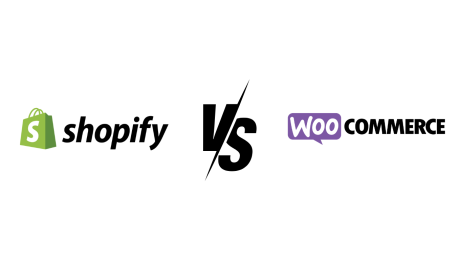Comparing Shopify and WooCommerce: Make the Right Choice for Your Ecommerce Journey
Ready to Set Up Your E-commerce Store? Choose Wisely!
E-commerce has boomed recently, opening doors for businesses worldwide. For e-commerce setup, Shopify and WooCommerce stand out. They each have distinct advantages, making the platform choice crucial for anyone entering online retail. In this blog, we’ll dive into the comparison of Shopify and WooCommerce, and explore how Shopify’s new personalized merchant experience plays a role in this dynamic landscape.
Shopify: The E-commerce Powerhouse
Shopify has established itself as a powerhouse in the e-commerce realm. Known for its user-friendly interface and extensive range of built-in tools, it’s a go-to choice for both newcomers and experienced retailers. One of Shopify’s standout features is its simplicity – you don’t need to be a tech expert to set up and manage your store effectively.
Shopify has recently taken a step forward by offering a personalized merchant experience through Re-platformer landing pages. This initiative is targeted at those who are considering migrating their existing stores to Shopify. The tailored in-admin migration support ensures a smooth transition, minimizing disruptions to your business operations. Furthermore, merchants can access additional tools such as migration-focused setup guides and sales guidance. This comprehensive support can significantly ease the often daunting process of migrating your store.
Pros of selling on shopify:
- User-friendly interface, perfect for beginners.
- Hosted solution, eliminating the need for separate hosting.
- Variety of professional templates and themes.
- Robust app store for adding functionalities.
- 24/7 customer support.
Cons of Shopify store:
- Monthly subscription costs.
- Limited customization compared to open-source solutions.
- Transaction charges for using payment channels from third parties.
- Advanced features might require coding or app integration.
WooCommerce: The WordPress Integration
WooCommerce, on the other hand, is an open-source ecommerce plug-in designed to integrate seamlessly with WordPress websites. This makes it an ideal choice for those who are already familiar with WordPress or want more control over the customization of their online store.
One of Woo Commerce’s biggest advantages is its flexibility. You have complete access over the store’s design, functionality, and hosting. With access to thousands of WordPress themes and plug-in, you can tailor your store to your exact specifications.
Pros:
- Open-source and free to use (though you might incur other costs like hosting and domain).
- Complete customization control.
- Extensive range of plug-in and extensions.
- Integrated blogging capabilities through WordPress.
- No transaction fees for using third-party payment gateways.
Cons:
- Requires separate hosting and domain setup.
- More technical expertise might be needed for setup and maintenance.
- You’re responsible for security and updates.
- Some plug-in can be costly.
Making the Choice
Choosing between Shopify and WooCommerce depends on your specific needs and priorities. If you’re seeking a hassle-free solution with a focus on user-friendliness and seamless migration, Shopify’s personalized merchant experience is a strong selling point. On the other hand, if you prioritize customization, flexibility, and are comfortable with more technical aspects, WooCommerce might be the better fit.
Both Shopify and WooCommerce offer exceptional tools to help you establish and grow your online store. With Shopify’s recent efforts to provide targeted migration support and tools, it’s becoming an even more attractive option for those looking to make the switch.
10 features Shopify has better than WooCommerce: Why merchants prefer Shopify
In the dynamic world of e-commerce, selecting the right platform to power your online store is a decision that can greatly influence your success. Shopify and WooCommerce are two prominent contenders, each offering a range of features tailored to various needs. Let’s delve into 10 things Shopify can do better than WooCommerce, shedding light on why merchants often lean towards Shopify for their e-commerce ventures.
1. Simplicity and User-Friendly Interface: Shopify is renowned for its intuitive interface that requires minimal technical knowledge to set up and manage a store. Its streamlined design and straightforward setup process make it an ideal choice for entrepreneurs who want to dive into the world of e-commerce without a steep learning curve.
2. Hosted Solution: Unlike WooCommerce, which requires separate hosting and domain setup, Shopify provides a fully hosted solution. This means Shopify takes care of the technical aspects, including server maintenance and security updates, allowing merchants to focus more on their business.
3. Extensive Range of Professional Templates: Shopify offers a wide selection of professionally designed templates that cater to various industries and styles. These templates provide a solid foundation for your store’s design, allowing you to create a visually appealing and engaging online shopping experience.
4. Integrated Payment Gateways: Shopify comes with built-in support for various payment gateways, simplifying the payment process for customers. Merchants don’t need to worry about third-party integrations to accept payments, making it convenient for both sides of the transaction.
5. Robust App Store: Shopify’s app store boasts an extensive range of apps and integrations that can enhance your store’s functionality. From marketing tools to inventory management and beyond, these apps allow you to customize your store’s features without extensive coding.
6. 24/7 Customer Support: Shopify provides 24/7 customer support via various channels, ensuring that merchants receive timely assistance whenever they encounter issues or have questions.
7. Mobile Responsiveness: Shopify’s templates are designed to be mobile-responsive out of the box. This is crucial in the age of mobile shopping, ensuring that your store provides a seamless experience across devices.
8. Security and Updates: Shopify takes care of security and updates, relieving merchants of the burden of managing these aspects. This saves valuable time and resources.
9. Scalability: Shopify is well-equipped to handle the growth of your business. As your store expands, Shopify’s infrastructure can accommodate increased traffic and orders without compromising performance.
10. Personalized Merchant Experience: Shopify’s recent initiative to provide a personalized merchant experience through Re-platformer landing pages offers tailored migration support and additional tools for a smoother transition. This can be a significant advantage for merchants looking to migrate their stores.
Why Merchants Prefer Shopify to WooCommerce
Merchants often prefer Shopify due to its user-friendliness, hassle-free setup, and strong support. Entrepreneurs prioritize products and customers over technical complexities, and Shopify’s professional templates and robust assistance cater to these needs. Personalized migration support adds to its appeal. In short, Shopify’s simplicity, comprehensive support, and feature-rich environment make it the go-to choice for reliable e-commerce.
Ready to Take the Next Step? Choose Your Ecommerce Powerhouse!
As you navigate the exciting world of e-commerce, the decision between Shopify and WooCommerce is pivotal to your online store’s success. Both platforms respond to various needs and preferences while offering distinctive features and advantages. Whether you’re drawn to Shopify’s user-friendly interface and comprehensive support or WooCommerce’s customization and control, the choice ultimately hinges on what aligns best with your business vision.
If you’re intrigued by Shopify’s simplicity, powerful features, and personalized migration support, why not take advantage of their tailored merchant experience? Sign up for Shopify today with Mean3
Are you considering a Shopify store and in need of professional guidance? Look no further. Contact Mean3, your official Shopify experts.
Don’t believe us? Learn about us through ‘For shopify store you will need an official shopify expert like Mean3.
- Published in Shopify, Technology




